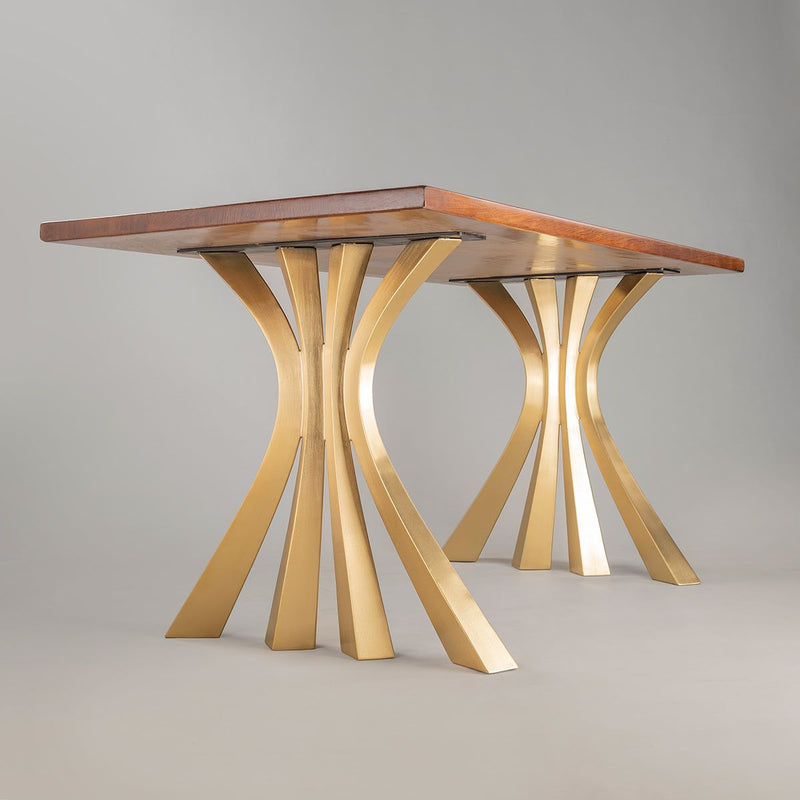Special Dining Room Table Legs to Change Your Dining Area
Special Dining Room Table Legs to Change Your Dining Area
Blog Article
A Thorough Appearance at Dining Table Leg Styles: Discovering the Suitable Match
Choosing the right dining table leg style is crucial for both aesthetic allure and functional capability. For those with larger tables, trestle legs make certain durable support, whereas hairpin legs introduce a mid-century modern-day ambiance with their minimalist design. The x-shaped legs blend contemporary style with enhanced stability.
Conventional Four Legs
Amongst the numerous kinds of dining table leg designs, the traditional four-leg design stays a classic option for numerous families. This classic setup offers an unified blend of capability and aesthetics, making it a seasonal fave. 4 legs give balanced assistance, making sure the table stays steady and with the ability of bearing substantial weight. This is especially beneficial for houses that often organize huge gatherings or utilize their table for multiple purposes, such as job or crafting.
From a visual viewpoint, the conventional four-leg design can be quickly adjusted to numerous interior styles. Whether crafted from timber, metal, or a combination of materials, these legs can be intricately carved, smooth and minimalistic, or anything in between. Their flexibility allows them to complement both rustic and contemporary settings seamlessly.
In addition, the straightforward structure of the four-leg design facilitates simplicity of motion and positioning within a space. Unlike more complex bases, this design reduces blockages, offering adequate legroom for restaurants. In summary, the traditional four-leg eating table leg style marries sustaining style with functional capability, making it an astute choice for those looking for both kind and function in their dining furnishings.
Stand Base
Often commemorated for its stylish and space-efficient style, the pedestal base is a distinguished option to the conventional four-leg arrangement in eating table leg styles. Without corner legs, diners are managed higher freedom of activity, making it an excellent option for round and oblong tables that promote more intimate and inclusive celebrations.
The main column itself offers a canvas for elaborate layouts and artistic expressions, including an element of aesthetic passion beneath the table. In recap, the pedestal base integrates performance with design, making it an improved and useful alternative for diverse dining settings.
Trestle Legs
Trestle legs give a robust and classic structure for dining tables, defined by their horizontal cross-bracing and sturdy assistance beam of lights. Originating from medieval times, this layout has progressed yet maintained its essential framework, making it a seasonal fave in both typical and modern setups. The main trestle beam, often supported by two or more vertical posts, uses exceptional security, permitting larger table sizes without the demand for additional legs.
A significant benefit of trestle leg tables is the enough legroom they use. Unlike tables with four edge legs, the absence of blockages at the table's edges offers unblocked space for chairs and restaurants, boosting convenience and access. This makes trestle tables suitable for fitting bigger events, whether in a dining-room or a banquet hall.
The aesthetic convenience of trestle legs is noteworthy. Readily available in a range of products such as timber, steel, and composite, they can be ended up to enhance a variety of interior designs. From rustic farmhouse to smooth contemporary styles, trestle legs can be customized to fit specific preferences. Their enduring appeal and functional benefits make trestle legs an engaging selection for those seeking both style and usefulness in their table.
Hairpin Legs

The charm of barrette legs exists in their simpleness and versatility - dining room table legs. Offered in a variety of products, including steel and brass, they can be ended up in various colors to match various interior designs. Whether coupled with a rustic wooden tabletop or a modern glass surface area, hairpin legs easily mix capability with a touch of vintage charm
Toughness is an additional noteworthy function of hairpin legs. Despite their delicate appearance, these legs are crafted to bear substantial weight, making certain the eating table stays steady and safe. Furthermore, they are reasonably very easy to set up, making them a popular option for do it yourself fanatics and professional furniture manufacturers alike.
X-Shaped Legs

Created from materials such as steel, wood, or a mix of both, X-shaped legs can be customized to match various layout preferences. Steel legs frequently lend a streamlined and commercial feel, perfect for loft-style apartments and modern-day dining rooms. On the other hand, wooden X-shaped legs offer a warmer, extra rustic appeal, suitable for farmhouse or eclectic insides. The adaptability in products allows home owners to tailor their eating tables to better fit their general style scheme.
Moreover, the design behind X-shaped legs guarantees also weight distribution, decreasing the risk of tottering and improving durability. This makes them specifically appropriate for larger dining tables that need extra support. Fundamentally, X-shaped legs blend functional design with modern-day aesthetics, making them a classic choice for diverse eating atmospheres.
Final Thought
A comprehensive understanding of table leg designs reveals the distinctive attributes and advantages of each style. Typical four legs supply stability and timeless charm, while stand bases offer legroom and link a structured appearance. Trestle legs make certain robust support for bigger tables, and barrette legs introduce a mid-century contemporary visual. X-shaped legs integrate modern style with boosted security. Selecting the appropriate leg design guarantees both useful and visual contentment in any type of dining room.
Report this page